Wildlife FAQs
Do not handle the animal. Call the Wildlife Center at 330.477.0448 for instructions or follow the voicemail instructions.
Put a radio in the attic or pointed under your porch/shed. Leave it on a hard rock station (just loud enough to have a constant sound) for three days and three nights. On the fourth day if the animal is gone, close up any holes to deter more unwanted visitors.
Cat saliva is full of bacteria and can be very harmful to wildlife. Dogs can cause unseen internal injuries if they catch an animal in their mouth. Call the center to bring the animal in to get examined.
If the bat was found in a bedroom overnight with a sleeping child or adult, please call your local health department. Otherwise, close off the room that the bat was found in and open a non-screened window at least two inches. It will find its way out after dark. If this is not an option, wait until the bat is motionless to a place box, coffee can, or similar object over the bat. Take a piece of cardboard and slide it between the object and the surface the bat is on containing the bat. Take it outside and lift the container while holding it about five feet off the ground to allow the bat to fly away. Do not release a bat during the day or during cold/bad weather.
No. Wild animals are protected by federal and state laws, making it illegal for anyone to possess them without the proper permits.
We can offer a variety of tips to help deter nuisance animals. Remember that if wildlife do not have suitable shelter or a food sources, they will probably not inhabit an area. Give us a call for safe solutions!
No. Animals cannot be released on park property.
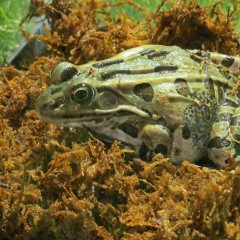 Injuries
Injuries
An amphibian will need to be brought into a rehabilitation center if:
- It appears to have any type of cut, wound, or abrasion
- It has been caught by a cat or dog
- It is found out during the winter months
The skin on amphibians is different than any other species, so care must be taken when transporting them. They must be kept moist and cool, so a small plastic container with a moist paper towel inside will be best. Limit contact as much as possible to avoid transferring soaps, chemicals, or lotions to the skin of these animals.
Orphaned or not?
Amphibians are on their own from the time they are born, and will never truly be orphaned. The only time an amphibian will need to be brought into a rehabilitation center is if it has visible wounds or if it is found out in the winter months.
Uninvited Guests
Amphibians generally are not a large nuisance problem. However, a large insect population will attract amphibians. Controlling the insect population is the best way to deter amphibians from an area.
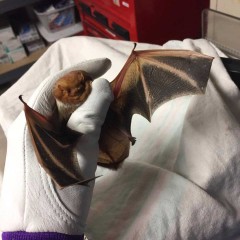
Bats are nocturnal, so any bat that is down during the day will need help. Most encounters will be with adults unless it is late May through July when babies are born. Injuries are usually due to predator attacks such as hawks, owls, and cats.
Although they are considered rabies vectors, rabid bats usually live only a short time after becoming infected. If you discover a bat inside a room where a person has been asleep, capture it and take it to the local health department for testing.
Injuries
A bat will need to be brought to a rehabilitation center if:
- It has severe visible and/or incapacitating wounds
- It is not able to move
- It is not able to fly. Note: Bats are not able to fly off of a horizontal surface. They must be vertical.
- It is grounded
- It is extremely lethargic
- It has been perching in the same spot out in the open for more than 30 minutes
- It has been caught by a cat or dog
Orphaned or not?
Leave the bat alone if:
- You find it perching in the woods
- Baby bats can be re-nested if you are able to find their roosting site. Place the bat as close to the roost as possible. Check back at night fall to make sure the bat re-joined the colony.
A bat may need to be brought to a rehabilitation center if:
- You find a baby bat and are not able to find the roost.
- You attempt to re-nest the bat and upon checking on it after night fall, it is alone in the same location you left it.
If you choose to capture a bat for treatment, protect yourself from bites by using thick gloves and avoid direct contact. Wait until the bat is motionless, then place a Tupperware container over it and slide a piece of paper between the container and the object it is perching on. Once in the container, put on a lid with small holes for air. If you are transporting a baby, add supplemental heat via a warm water bottle or hands warmers covered by a thin towel or paper towel. Be sure to secure the water bottle so it does not roll over the baby during transport. NEVER attempt to give an animal food- inappropriate food or feedings can severely damage or kill wildlife.
Uninvited Guests
What to Do if You Find a Bat in Your House
- Leave a window open for it to leave during the night. It will find it!
- Using thick gloves and avoiding direct contact, contain it by placing a Tupperware container over it and sliding a piece of paper/cardboard between the container and the object it is perching on. Once in the container, put on a lid with small holes for air. Take outdoors and place container on a vertical surface such as a tree and let the bat attach.
- If you find a bat in a room where someone was sleeping, the bat will need to be taken to your local health department for testing.
How to Deter an Unwanted Colony from an Area
- Make their living environment uncomfortable with noise and light
- Set a radio near the colony and play it constantly on a hard rock station for three days and three nights. It must be loud enough to be heard throughout the area.
- Flood lights can be left on constantly for the three days illuminating the area create a light disturbance in addition to the noise
- Once the colony has relocated, be sure to patch up any holes or possible entryways
 Injuries
Injuries
A chipmunk will need to be brought into a rehabilitation center if:
- It has severe visible and/or incapacitating wounds
- It appears disoriented/unstable
- It is an adult that is unable to flee from you
- It is covered in flies, maggots, or other parasites
- It appears lethargic, is lying on its side, or is cold and stiff
- It has been caught by a cat or dog
Orphaned or not?
Young chipmunks do not appear above ground until they are fairly independent and a minimum of six weeks old.
Leave the chipmunk alone if:
- It appears to be uninjured
- You see it eating on its own
A baby chipmunk may need to be brought into a rehabilitation center if:
- It is furless, the eyes are closed, and it is found without its mother
- It is a baby that appears lethargic and/or disoriented
- It is covered in parasites
Keep the animal in a warm, quiet, dark location where it will be protected until you can bring it to a rehabilitation center. Young animals should be given a heat source, especially if kept overnight. NEVER attempt to give an animal food - inappropriate food or feedings can severely damage or kill wildlife.
Uninvited Guests
How to Deter Chipmunks from Your Yard/Garden
- Remove any easily accessible food sources such as a bird feeder, or outside pet food
- Use scare tactics to persuade them to leave on their own. These include loud noises such as obnoxious music, predator urine (can be purchased at hunting retailers), and rodent deterrents such as Critter Ridder.
- Live traps can be used to catch chipmunks as long as laws for trapping and relocating are followed.
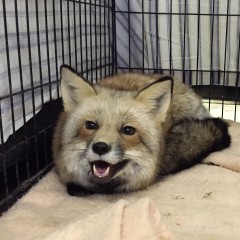 Do not touch a fox! Observe only. Foxes are a species of concern as a rabies carrier and can be aggressive. Injuries (which may peak in December through February due to breeding season) are usually caused by car hits, poisoning, snare traps, or self-inflicted wounds due to mange. Cubs may surface form April to May while they practice their developing skills outside their dens. Parents will leave cubs alone several times to hunt for food. Cubs should only be taken into captivity as a last resort!
Do not touch a fox! Observe only. Foxes are a species of concern as a rabies carrier and can be aggressive. Injuries (which may peak in December through February due to breeding season) are usually caused by car hits, poisoning, snare traps, or self-inflicted wounds due to mange. Cubs may surface form April to May while they practice their developing skills outside their dens. Parents will leave cubs alone several times to hunt for food. Cubs should only be taken into captivity as a last resort!
Injuries
Leave the fox alone if:
- It is out during daylight hours but is not showing any signs of being ill. It may be a mother out hunting for some extra food, observe her behavior- if it appears normal leave her alone.
The Wildlife Conservation Center does not accept adult foxes. If you encounter one that may need help contact Division of Wildlife at 1.800.WILDLIFE. A fox is likely in need of help if:
- It has severe visible and/or incapacitating wounds
- It appears disoriented/unstable or is rolling/spinning
- It is an adult that is unable to flee from you
- It is extremely lethargic
- It is covered in flies, maggots, or other parasites
- It has missing fur and is weak
- It has been attacked by a cat or dog
Orphaned or not?
Leave the fox alone if:
- It is a kit seen outside the den ‘playing’ during the day and a parent collects it within 24 hours
A fox may need to be brought to a rehabilitation center if:
- You find it alone and its eyes are closed
- You observe a healthy, eyes-opened, mobile kit for a period of 12 to 24 hours and a parent never comes to collect it
If you choose to capture one for treatment, protect yourself from bites by using thick gloves and avoid direct contact. Wait until the fox is motionless, and then gently toss a large box over it. Slide a piece of board under the box, containing it. Once contained, you can gently tip the box up-right and secure the board with duct tape. Other options include luring the fox into a dog carrier using canned cat or dog food and closing the door once the fox enters or setting a live trap.
Keep the animal in a warm, quiet, dark location where it will be protected until you can bring it to a rehabilitation center. Young animals should be given a heat source, especially if kept overnight. NEVER attempt to give an animal food- inappropriate food or feedings can severely damage or kill wildlife.
Unwanted Guests
How to Evict an Unwanted Fox from an Area
- Make its living environment uncomfortable with noise, light, and smell
- Set a radio near where the fox is entering (without blocking it) and play it constantly on a hard rock station for three days and three nights. It must be loud enough to be heard throughout the area.
- Flood lights can be left on constantly for the three days illuminating the area create a light disturbance in addition to the noise
- Human adult male urine! Yup, that’s right! Have an adult male urinate around the area(s) you don’t want the fox!
- If the fox has young, she should take them with her when she relocates
- On the fourth day or when you know the fox to be gone, however it got in in the first place must be addressed to prevent it from happening again.
 Injuries
Injuries
An adult will need to be brought to a rehabilitation center if:
- It has severe visible and/or incapacitating wounds
- It is unable to fly away from you
- It was hit by a car
- It hit a window
Orphaned or not?
A baby bird with white or gray downy feathers is out of the nest prematurely and needs your help. Try to locate the nest and return the bird if possible.
If you cannot locate the nest or notice any of the problems listed below please bring the bird in for rehabilitation:
- It is cold to the touch
- It is lying on its side
- It is weak and unresponsive
- It has visible injuries
- It has been caught by a cat or dog
Fledgling birds are very vulnerable and are not yet able to fly. Parent birds are still around taking care of the young. Leave the fledgling bird alone if:
- It is covered in feathers and appears healthy
- You see parents feeding the young bird
Please keep cats indoors and dogs on a leash if you notice a fledgling in your yard. These young birds will be able to fly within a week or two.
Uninvited guests
All native birds are protected by the migratory bird treaty act of 1918. You may not disturb the nest, eggs or young of any native species. If you have any questions or concerns regarding native migratory birds please give us a call or visit https://www.fws.gov/birds/policies-and-regulations/laws-legislations/migratory-bird-treaty-act.php.
 Injuries
Injuries
Leave the opossum alone if:
- It is out during the day but appears to be healthy and otherwise acting normal
- The opossum has its mouth open wide, is showing all of its teeth, and is drooling excessively- this is simply a defense mechanism and does not mean the animal is rabid. If it otherwise appears to be healthy, leave it alone.
An opossum will need to be brought into a rehabilitation center if:
- It has severe visible and/or incapacitating wounds
- It appears disoriented/unstable
- It is an adult that is unable to flee from you
- It is extremely lethargic
- It is covered in flies, maggots, or other parasites
- It has been caught by a cat or dog
If you choose to capture one for treatment, remember to protect yourself from the opossum’s sharp teeth and claws.
Orphaned or not?
Leave the opossum alone if:
- It is about six inches long (not including the tail) or bigger and appears to be healthy
A baby opossum may need to be brought into a rehabilitation center if:
- It is furless and without its mother
- It is found inside the pouch of or crawling on a dead mother
- It has fur but is smaller than six inches and without its mother
- Do not disturb the area and keep all pets and children away and give the mother a chance to retrieve it. If the mother does not immediately return, it will need help
- It appears to be sick, cold, weak, injured, or covered in parasites
Keep the animal in a warm, quiet, dark location where it will be protected until you can bring it to a rehabilitation center. Young animals should be given a heat source, especially if kept overnight. Baby opossums should have a source of both heat and humidity- place a warm, wet sponge or cloth in the box as well. NEVER attempt to give an animal food - inappropriate food or feedings can severely damage or kill wildlife.
Uninvited Guests
How to Deter Visiting Opossums
Opossums usually only come around when there is a readily available food source.
- Try to determine if there is something attracting them there and address it
- Secure or bring in all trash cans at night
- Pick up any outdoor pet food
- General deterring tips:
- Use Critter Ridder (available at TSC or garden supply stores) around perimeter of area where you don’t want the animal to be
- Place vinegar or ammonia-soaked rags or fox urine (available in hunting supply stores) in the area. These may have to be refreshed several times a day.
How to Evict an Opossum Living under the Shed/Porch/Deck
Opossums are nocturnal- wait until he is out for the night (anytime between midnight and dawn) and seal the entrance. Secure outbuildings with heavy-duty hardware cloth or poultry wire. For woodpiles place a vinegar or ammonia-soaked rag near the entrance.
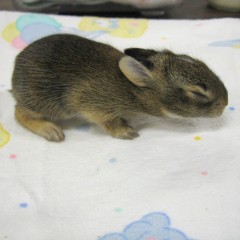 Injuries
Injuries
Leave the rabbit alone if:
- It has no noticeable injuries
- It is capable of running from you
A rabbit will need to be brought to a rehabilitation center if:
- It has severe visible and/or incapacitating wounds
- It appears disoriented/unstable or is rolling/spinning
- It is an adult that is unable to flee from you
- It is extremely lethargic
- It is covered in flies, maggots, or other parasites
- It has been caught by a cat or dog
Small amounts of stress can easily kill confined wild rabbits, so handle them as little as possible.
Orphaned or not?
Chances are that you will never see a mother rabbit- this does not mean the nest is abandoned! Mothers only visit their nests at the end of the day and early morning and stay with the kits for less than 5 minutes, so don’t assume that a litter is orphaned unless you see the mother dead.
Leave the rabbit alone if:
- The rabbit is larger than a tennis ball with its eyes open, and ears are erect
- The rabbit is large enough to be on its own and is uninjured but appears to be “frozen” in one spot. This rabbit most likely trying to go unnoticed, if you can approach the rabbit, place it in an area close to where is it found with some cover such as high weeds and check on it a half hour later- it will most likely be gone.
- The nest has been destroyed but the kits appear healthy and uninjured. Place them in their exact nesting spot and recreate the nest with grass or any remaining nesting materials.
A baby rabbit may need to be brought into a rehabilitation center if:
- You are positive the nest has been abandoned for over 24 hours and the babies are unfurred, have their eyes closed, and are smaller than a tennis ball.
- To check if the nest is truly abandoned, place some small twigs or string across the nest in an intricate pattern (not two twigs in an X) and check for displacement in the morning. If it has been disrupted it means the mother is still around- leave it alone.
- Babies are thin, lethargic, or laying on their sides
- Have been attacked by a predator, including cats and dogs
- Have been injured by lawn equipment. If the nest has been destroyed but the kits appear uninjured leave them in their exact nesting spot and recreate the nest with the remaining nesting materials.
Keep the animal in a warm, quiet, dark location where it will be protected until you can bring it to a rehabilitation center. Young animals should be given a heat source, especially if kept overnight. NEVER attempt to give an animal food - inappropriate food or feedings can severely damage or kill wildlife. Baby rabbits need an enriched, specialized formula for their rapid rate of growth, so cow’s milk, human formulas, formulas made from canned milk and eggs, or even the wrong pet formulas can result in death
Uninvited Guests
How to Protect an Existing Nest from a Pet
If your pet discovers a nest, leave unharmed babies in the nest and protect it from future intrusions by temporarily covering it with an upside-down laundry basket during the day and removing it at night, so the mother can visit.
How to Deter Rabbits from Nesting in Your Yard/Garden
A mother rabbit should never be deterred from visiting her nest. If you have a nest in your yard try to be patient, baby cottontails are on their own at only three to four weeks old. After they have left the nest use the following methods to prevent her from nesting in the same spot in the future.
- Critter Ridder (available at TSC or garden supply stores), cat-urine soaked clumps of litter, fox urine, coyote urine, vinegar or ammonia-soaked rags, or home-made repellants such as ground pepper or garlic powder can be effective.
- A fence is the best way to protect a garden, it should be one to one and a half feet high to keep out rabbits.
- Rabbits do not like Magnolia flowers, planting some around your property, unwanted nesting sites, or throughout the garden can help keep them away from the area.

Due to confirmed rabies cases in raccoons in the Stark County area, the Wildlife Center cannot accept any raccoons for rehabilitation until further notice. We will continue to offer natural deterrents and alternative methods when raccoons den in attics, chimneys, or under porches or sheds. We recommend playing a radio on a hard rock station for 3 days and nights to create a consistent noise. The adult will be annoyed and move any young with her.
How to Deter Raccoons from Your Property
Raccoons frequent areas where there are resources available to them. Taking away these resources will deter the animal from coming back.
- Secure trash lids or coat the trash can with a small amount of cayenne pepper in water. This will prevent the raccoon from getting in the trash.
- Bring in any pet food that you normally leave out overnight.
- Move bird feeders away from any structures. Set these feeders up on metal poles to prevent them from climbing. Plastic structures can also be bought to put around the poles of feeders to prevent them from climbing. Use ammonia or Critter Ridder in these areas to deter them from coming near the feeders.
- Compost piles should be covered at night, or kept in a garage or shed.
How to Evict a Resident Raccoon Living in the Chimney/Attic
First determine if baby raccoons are present. Try to avoid evicting any raccoons while young are still in the nest. The mother will move them on her own when they are about 9 weeks of age.
- Make its living environment uncomfortable with noise, light, and smell
- Set a radio near where the raccoon is entering (without blocking it) and play it constantly on a hard rock station for three days and three nights. It must be loud enough to be heard throughout the area.
- Flood lights can be left on constantly for the three days illuminating the area create a light disturbance in addition to the noise
- Try placing vinegar or ammonia-soaked rags, cat-urine soaked clumps of litter, or fox urine (available at hunting supply stores) in the area to discourage raccoons- quantity will depend on the size of the area. These may have to be refreshed several times a day.
- If the raccoon has young, she should take them with her when she relocates.
- On the fourth day or when you know the raccoon to be gone, however it got in in the first place must be addressed to prevent it from happening again.
- Trim any branches or tree limbs that are close to the house or roof. This will help prevent raccoons from climbing onto your house and getting inside.
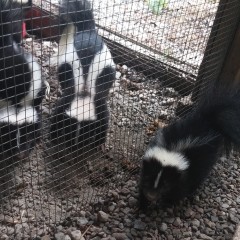 De-Skunking Recipe
De-Skunking Recipe
Mix one quart of peroxide (3%) with ¼ cup baking soda and one teaspoon liquid soap. Bathe in this mixture then rinse with water. Repeat as necessary.
Injuries
Leave the skunk alone if:
- It is out during daylight hours but is not showing any signs of being ill. It may be a mother out hunting for some extra food, observe her behavior- if it appears normal leave her alone.
The Wildlife Conservation Center does not accept adult skunks. If you encounter one that may need help contact Division of Wildlife at 1.800.WILDLIFE. A skunk is likely in need of help if:
- It has severe visible and/or incapacitating wounds
- It appears disoriented/unstable or is rolling/spinning
- It is an adult that is unable to flee from you
- It is extremely lethargic
- It is covered in flies, maggots, or other parasites
- It has been caught by a cat or dog
Orphaned or not?
Leave the skunk alone if:
- It has no noticeable injuries
- It is about six to eight inches long (not including the tail), seems to be active and normal and is playing around or digging
- It seems too small to be out on its own but is otherwise healthy
- Replace it back in the den, or keep it protected from the heat/cold during the day and put it back where you found it at night for the mother to reclaim
A skunk may need to be brought to a rehabilitation center if:
- It is far from its den and appears to be sick, cold, weak, injured, spinning, extremely lethargic, or covered in parasites
- It appears to be healthy but is following you around
- If the mother is known to be dead or a found baby is not reclaimed by the mother within a day
Caution: skunks can begin to spray as young as six weeks old! Keep the animal in a warm, quiet, dark location where it will be protected until you can bring it to a rehabilitation center. Young animals should be given a heat source, especially if kept overnight. NEVER attempt to give an animal food- inappropriate food or feedings can severely damage or kill wildlife.
Uninvited Guests
How to Evict a Resident Skunk Living under the Shed/Porch/Deck
- Make its living environment uncomfortable with noise, light, and smell
- Set a radio near where the skunk is entering (without blocking it) and play it constantly on a hard rock station for three days and three nights. It must be loud enough to be heard throughout the area.
- Flood lights can be left on constantly for the three days illuminating the area create a light disturbance in addition to the noise
- Try placing vinegar or ammonia-soaked rags, cat-urine soaked clumps of litter, cat feces, or fox urine (available at hunting supply stores) under the shed/porch/deck to discourage skunks- quantity will depend on the size of the area. These may have to be refreshed several times a day.
- If the skunk has young, she should take them with her when she relocates
- On the fourth day or when you know the skunk to be gone, however it got in in the first place must be addressed to prevent it from happening again.
How to Prevent a Skunk from Making a Den in your Yard
- Avoid having junk or wood piles in open areas
- If a skunk has recently been evicted, fill in the vacant den with dirt
- Screen off gaps underneath structures with heavy hardware cloth or fencing buried at least one foot beneath the ground with the lower six inches at a 90° outward angle so they cannot tunnel under it.
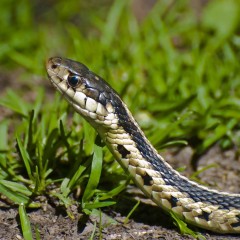 Most snakes found in Ohio (particularly northern Ohio) are completely harmless. There are no venomous snakes found in Stark County. For help identifying a snake, please reference the field guides available on the Ohio Division of Wildlife’s website: http://wildlife.ohiodnr.gov/
Most snakes found in Ohio (particularly northern Ohio) are completely harmless. There are no venomous snakes found in Stark County. For help identifying a snake, please reference the field guides available on the Ohio Division of Wildlife’s website: http://wildlife.ohiodnr.gov/
The three types of venomous snakes in Ohio that will not be accepted into the center for rehabilitation are the Copperhead, Timber Rattlesnake, and the Massasauga Rattlesnake.
Injuries
Leave the snake alone if:
- It does not appear to be injured- simply seeing a snake on your property is normal and is no cause for alarm!
- The snake is curled up and not moving but doesn’t appear to be injured- this is common behavior for snakes
A snake will need to be brought into a rehabilitation center if:
- It appears to have any type of cut, wound, or abrasion
- It has been caught by a cat or dog
Orphaned or not?
Snakes are on their own from the time they are born, and will never truly be orphaned. The only time a snake will need to be brought into a rehabilitation center is if it has visible wounds.
Uninvited Guests
Snakes are great for the environment in that they control the rodent and insect population.
How to Deter Unwanted Snakes from an Area
- Control the rodent and insect population in the area. This will take away the resources for the snakes.
- Remove piles of junk and debris, and keeping the grass cut short. Snakes find these areas to be perfect shelters and homes.
How to Remove a Snake from a Basement/Cellar
- Place a burlap sack on the floor- this dark place will attract the snake for easy capture
- If the snake does not venture into the sack by the end of the day, you can pick the snake up using a hook, hoe, or a slip-knot and place the snake inside of the bag
- Once captured, immediately transport the snake to a woodlot or brush pile about a mile away from the point of capture and away from other houses
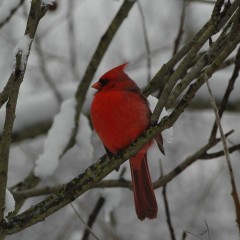 Injuries
Injuries
An adult songbird will need to be brought to a rehabilitation center if:
- It has severe visible and/or incapacitating wounds
- It is unable to fly away from you
- It has been caught by a cat or dog
- It was hit by a car
- It hit a window
Orphaned or not?
Contrary to popular belief, parent birds will not reject a baby bird with human scent on it. Most birds have excellent vision and hearing but a poorly developed sense of smell. A baby bird without any feathers is out of the nest prematurely and needs your help. Try to locate the nest and return the bird if possible.
If you cannot locate the nest or notice any of the problems listed please bring the bird in for rehabilitation:
- It is cold to the touch
- It is lying on its side
- It is weak and unresponsive
- It has visible injuries
- It has been caught by a cat or dog
Fledgling birds are very vulnerable and are not yet able to fly. Parent birds are still around taking care of the young. Leave the fledgling bird alone if:
- It is covered in feathers and appears healthy
- You see parents feeding the young bird
Please keep cats indoors and dogs on a leash if you notice a fledgling in your yard. These young birds will be able to fly within a week.
Uninvited guests
All native birds are protected by the migratory bird treaty act of 1918. You may not disturb the nest, eggs or young of any native species. If you have any questions or concerns regarding native migratory birds please give us a call or visit https://www.fws.gov/birds/policies-and-regulations/laws-legislations/migratory-bird-treaty-act.php.
 Injuries
Injuries
A squirrel will need to be brought to a rehabilitation center if:
- It has severe visible and/or incapacitating wounds
- It appears disoriented/unstable after a fall
- It is an adult that is unable to flee from you
- It is extremely lethargic
- It is covered in flies, maggots, or other parasites
- It has missing fur or appears to have a skin infection
- It has been caught by a cat or dog
Orphaned or not?
If you have found an infant baby squirrel lying on the ground, check it briefly for injuries and body temperature. If it appears to look healthy, is warm, and is close to a tree, the squirrel may be able to be reunited with its mother.
- Steps to reuniting:
- Place the young squirrel in a small box. Hang this box as high up in the tree as you can reach by securing it with bungee cords or another form of support.
- If it is a cold day outside, fill a tightly sealed bottle of water or jar with warm water, and cover this with a thin cloth or a sock. Place this inside of the box with the baby squirrel. This will help to keep the baby warm until it is reunited with its mother.
- Leave the area and allow time for the mother to return. Observe the baby throughout the day for any changes in its condition, and to check to make sure the bottle is still warm.
- If the mother has not returned for the baby by dark, bring it inside and keep it in a warm, dark, and quiet place. Do not try and feed the baby anything, even if you have to keep it overnight, as incorrect feeding can be fatal. Call the center and bring it in for care as soon as possible.
- Sometimes juvenile squirrels will venture far from their nest and get lost. When they get hungry, they will climb onto anything moving, such as humans or dogs. Try to find the nest tree, leave the squirrel there, and leave the area. The parents will coax the baby back up the tree.
A squirrel may need to be brought to a rehabilitation center if:
- The nest cannot be located
- It appears to be cold, weak, injured, or covered in parasites
Keep the animal in a warm, quiet, dark location where it will be protected until you can bring it to a rehabilitation center. Young animals should be given a heat source, especially if kept overnight. NEVER attempt to give an animal food- inappropriate food or feedings can severely damage or kill wildlife.
Uninvited Guests
Live-Trapping a Squirrel
Unfortunately, due to the high number of squirrels in any area, as soon as you live trap and relocate squirrels somewhere else, a new squirrel will quickly take its place in your residence, making this an ineffective solution.
How to Deter a Squirrel from Your Property
Remove or relocate foods that may be attracting squirrels to an area. This can include bird feeders, fruits, and vegetables. Taking away resources will make an animal go elsewhere in search of food.
How to Evict a Resident Squirrel Living in the Chimney/Attic
First determine if baby squirrels are present. Try to avoid evicting any squirrels while young are still in the nest.
- Make its living environment uncomfortable with noise, light, and smell
- Set a radio near where the squirrel is entering (without blocking it) and play it constantly on a hard rock station for three days and three nights. It must be loud enough to be heard throughout the area.
- Flood lights can be left on constantly for the three days illuminating the area create a light disturbance in addition to the noise
- Try placing vinegar or ammonia-soaked rags, cat-urine soaked clumps of litter, or fox urine (available at hunting supply stores) in the area to discourage squirrels- quantity will depend on the size of the area. These may have to be refreshed several times a day.
- If the squirrel has young, she should take them with her when she relocates
- On the fourth day or when you know the squirrels to be gone, however they got in in the first place must be addressed to prevent it from happening again.
- Trim any branches or tree limbs that are close to the house or roof. This will prevent squirrels from jumping onto your house and getting inside.
How to Remove a Squirrel Trapped in Your Home
Open a window or a door, block off all other exits, and wait for the squirrel to leave on its own. Once it has left, determine how it might have entered and block it off.
 If you happen upon a turtle crossing the road, you may assist the turtle by placing it on the side of the road in the direction it was heading.
If you happen upon a turtle crossing the road, you may assist the turtle by placing it on the side of the road in the direction it was heading.
Injuries
A turtle will need to be brought to a rehabilitation center if:
- It has a cracked or broken shell
- It was hit by a car
- It has fishing line/hook attached
- It has severe visible and/or incapacitating wounds
Orphaned or not?
Young turtles are on their own from the moment they are born. Once they hatch they will locate the nearest body of water or suitable habitat. Please do not disturb them unless they appear injured. Even though they are small they will be fine!
Uninvited guests
At certain times of the year turtles will travel across land to lay their eggs. Please do not disturb them!
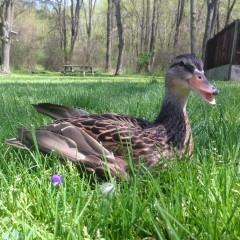 Injuries
Injuries
An adult will need to be brought to a rehabilitation center if:
- It has severe visible and/or incapacitating wounds
- It is unable to fly away or flee from you
- It has been attacked by a cat or dog
- It was hit by a car
- There is fishing line/hook attached
- It is covered in oil
Orphaned or not?
A baby bird that is alone needs your assistance. Bring the bird in if:
- It is cold to the touch
- The parents are known to be dead or are not in sight
- It is lying on its side
- It is weak and unresponsive
- It has visible injuries
- It has been caught by a cat
Please keep cats indoors and dogs on a leash if you notice a family of ducks or geese in your yard.
Uninvited guests
All native birds are protected by the migratory bird treaty act of 1918. You may not disturb the nest, eggs or young of any native species. If you have any questions or concerns regarding native migratory birds please give us a call or visit https://www.fws.gov/birds/policies-and-regulations/laws-legislations/migratory-bird-treaty-act.php.
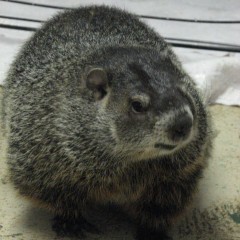 Injuries
Injuries
A woodchuck will need to be brought into a rehabilitation center if:
- It has severe visible and/or incapacitating wounds
- It appears disoriented/unstable
- It is an adult that is unable to flee from you
- It is extremely lethargic
- It is covered in flies, maggots, or other parasites
- It has been caught by a cat or dog
If you choose to capture one for treatment, remember to protect yourself from the woodchuck’s sharp teeth and claws.
Orphaned or not?
Leave the woodchuck alone if:
- It is the size of a football or bigger
- It appears to be healthy and the mother is known to be still be around (not necessarily on-site at the time)
A baby woodchuck may need to be brought into a rehabilitation center if:
- It is smaller than the size of a football and is out of its den
- If you can find a burrow nearby that you believe the woodchucks may be living in, try placing or coercing the baby to go closer to the hole and hopefully reunite with Mom. If the mother does not return for the baby within a couple of hours, it is most likely orphaned.
- It appears to be sick, cold, weak, injured, or covered in parasites
Keep the animal in a warm, quiet, dark location where it will be protected until you can bring it to a rehabilitation center. Young animals should be given a heat source, especially if kept overnight. NEVER attempt to give an animal food - inappropriate food or feedings can severely damage or kill wildlife.
Uninvited Guests
How to Evict a Resident Woodchuck Living under the Shed/Porch/Deck
- Make its living environment uncomfortable with noise, light, and smell
- Set a radio near where the woodchuck is entering (without blocking it) and play it constantly on a hard rock station for three days and three nights. It must be loud enough to be heard throughout the area.
- Flood lights can be left on constantly for the three days illuminating the area create a light disturbance in addition to the noise
- Try placing vinegar or ammonia-soaked rags, cat-urine soaked clumps of litter, or fox urine (available at hunting supply stores) under the shed/porch/deck to discourage woodchucks- quantity will depend on the size of the area. These may have to be refreshed several times a day.
- If the woodchuck has young, she should take them with her when she relocates
- On the fourth day or when you know the woodchuck to be gone, however it got in in the first place must be addressed to prevent it from happening again.
How to Prevent a Woodchuck from Burrowing in Your Yard
- Avoid having junk or wood piles in open areas
- If a woodchuck has recently been evicted, fill in the vacant burrow with dirt
- Screen off gaps underneath structures with heavy hardware cloth or fencing buried at least one foot beneath the ground with the lower six inches at a 90° outward angle so they cannot tunnel under it.
Protecting Your Garden
- A fence is the best way to protect a garden- it will also help keep rabbits, dogs, cats, and other animals out of the area
- Fences should be at least three feet high and made of heavy poultry wire or 2-inch woven mesh wire. Bury the lower edge 12 inches in the ground with the lower six inches bent at a 90° outward angle
- Place an electric wire four to five inches off the ground a few inches around the perimeter of the fence.
- Critter Ridder (available at TSC or garden supply stores), cat-urine soaked clumps of litter, fox urine, vinegar or ammonia-soaked rags, or home-made repellants such as ground pepper or garlic powder can also be effective
If you continue to experience problems with uninvited woodchucks, live-trapping is an option. Please see the Live Trapping section for trap rental information and important trapping and relocation regulations.
Recent Posts
Derby Circuit-Spring and Summer 2024 Kids (Ages 4-15) can join the 2024 fishing derby circuit and participate in free fishing derbies from April to August. Sponsored by Stark County Federation… More
Stark Parks celebrated volunteer accomplishments in 2023 at the annual Volunteer Recognition Dinner at the Exploration Gateway at Sippo Lake Park earlier this month. Through September, over 14,000 volunteer hours… More
A new Stark Parks logo is being debuted to better reflect the park mission and create more consistency throughout the organization. The last true redesign occurred over 25 years ago when… More
Beginning in March 2023, Stark Parks crews will begin preparing areas at Tam O'Shanter Park for parking lot and driveway updates including removing and relocating trees and vegetation. Construction will… More
We hope you enjoy the observations of eagle watching volunteers and invite you to stop by the nest site located on the west side of Walborn Reservoir at 13600 Marlboro… More
Geocaching is a great way to explore Stark Parks year-round! Find the hidden caches at different park locations and collect 12 out of 15 code words to win a unique… More








